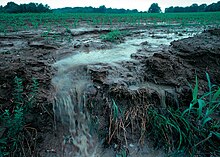
Back تلوث بالمغذيات Arabic Llygredd maetholion CY آلودگی مواد مغذی FA Gurbataccen abinci mai gina jiki HA Polusi nutrisi ID Nri mmetọ IG د مغذي موادو ککړتیا PS Poluição por nutriente Portuguese Besin kirliliği Turkish Забруднення поживними речовинами Ukrainian

| Part of a series on |
| Pollution |
|---|
 |
Nutrient pollution, a form of water pollution, refers to contamination by excessive inputs of nutrients. It is a primary cause of eutrophication of surface waters (lakes, rivers and coastal waters), in which excess nutrients, usually nitrogen or phosphorus, stimulate algal growth.[1] Sources of nutrient pollution include surface runoff from farm fields and pastures, discharges from septic tanks and feedlots, and emissions from combustion. Raw sewage is a large contributor to cultural eutrophication since sewage is high in nutrients. Releasing raw sewage into a large water body is referred to as sewage dumping, and still occurs all over the world. Excess reactive nitrogen compounds in the environment are associated with many large-scale environmental concerns. These include eutrophication of surface waters, harmful algal blooms, hypoxia, acid rain, nitrogen saturation in forests, and climate change.[2]
Since the agricultural boom in the 1910s and again in the 1940s to match the increase in food demand, agricultural production relies heavily on the use of fertilizers.[3] Fertilizer is a natural or chemically modified substance that helps soil become more fertile. These fertilizers contain high amounts of phosphorus and nitrogen, which results in excess amounts of nutrients entering the soil. Nitrogen, phosphorus and potassium are the "Big 3" primary nutrients in commercial fertilizers, each of these fundamental nutrients play a key role in plant nutrition.[4] When nitrogen and phosphorus are not fully utilized by the growing plants, they can be lost from the farm fields and negatively impact air and downstream water quality.[5] These nutrients can eventually end up in aquatic ecosystems and are a contributor to increased eutrophication.[6] When farmers spread their fertilizer, whether it is organic or synthetically made, some of it will leave as runoff and can collect downstream generating cultural eutrophication.[7]
Mitigation approaches to reduce nutrient pollutant discharges include nutrient remediation, nutrient trading and nutrient source apportionment.
- ^ Walters, Arlene, ed. (2016). Nutrient Pollution From Agricultural Production: Overview, Management and a Study of Chesapeake Bay. Hauppauge, NY: Nova Science Publishers. ISBN 978-1-63485-188-6.
- ^ "Reactive Nitrogen in the United States: An Analysis of Inputs, Flows, Consequences, and Management Options, A Report of the Science Advisory Board" (PDF). Washington, DC: US Environmental Protection Agency (EPA). EPA-SAB-11-013. Archived from the original (PDF) on February 19, 2013.
- ^ Seo Seongwon; Aramaki Toshiya; Hwang Yongwoo; Hanaki Keisuke (2004-01-01). "Environmental Impact of Solid Waste Treatment Methods in Korea". Journal of Environmental Engineering. 130 (1): 81–89. doi:10.1061/(ASCE)0733-9372(2004)130:1(81).
- ^ "Fertilizer 101: The Big Three―Nitrogen, Phosphorus and Potassium". Arlington, VA: The Fertilizer Institute. 2014-05-07. Archived from the original on 2023-06-05. Retrieved 2021-08-21.
- ^ "The Sources and Solutions: Agriculture". Nutrient Pollution. EPA. 2021-11-04.
- ^ Huang, Jing; Xu, Chang-chun; Ridoutt, Bradley; Wang, Xue-chun; Ren, Pin-an (August 2017). "Nitrogen and phosphorus losses and eutrophication potential associated with fertilizer application to cropland in China". Journal of Cleaner Production. 159: 171–179. Bibcode:2017JCPro.159..171H. doi:10.1016/j.jclepro.2017.05.008.
- ^ Carpenter, S. R.; Caraco, N. F.; Correll, D. L.; Howarth, R. W.; Sharpley, A. N.; Smith, V. H. (August 1998). "Nonpoint Pollution of Surface Waters with Phosphorus and Nitrogen". Ecological Applications. 8 (3): 559. doi:10.2307/2641247. hdl:1813/60811. JSTOR 2641247.